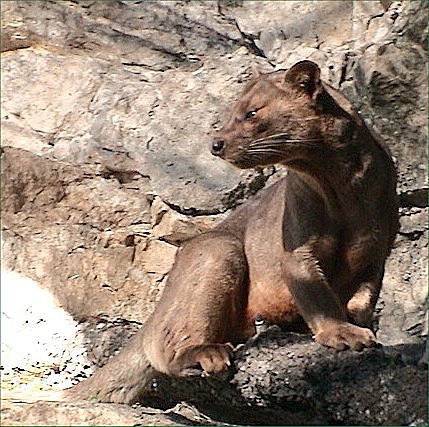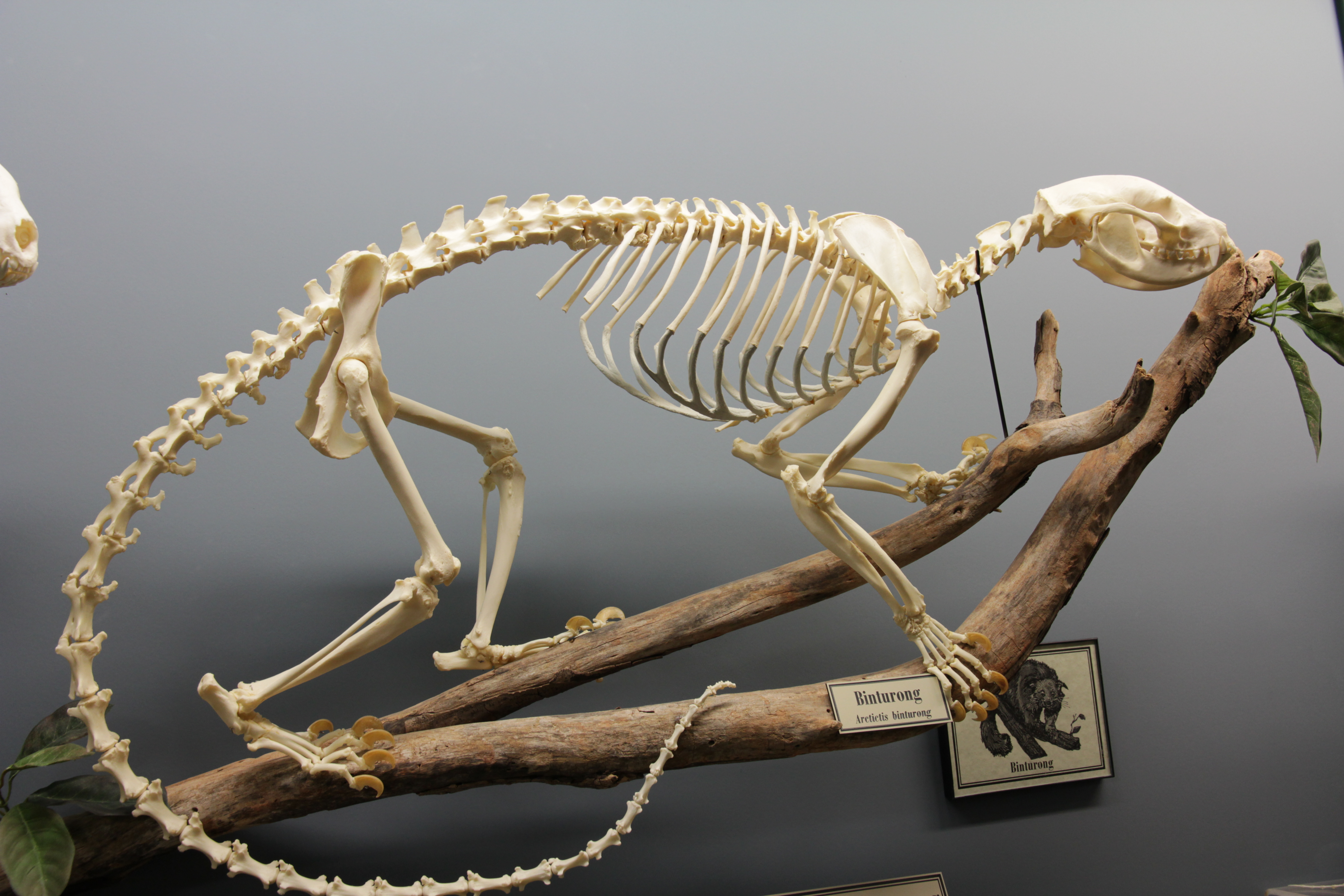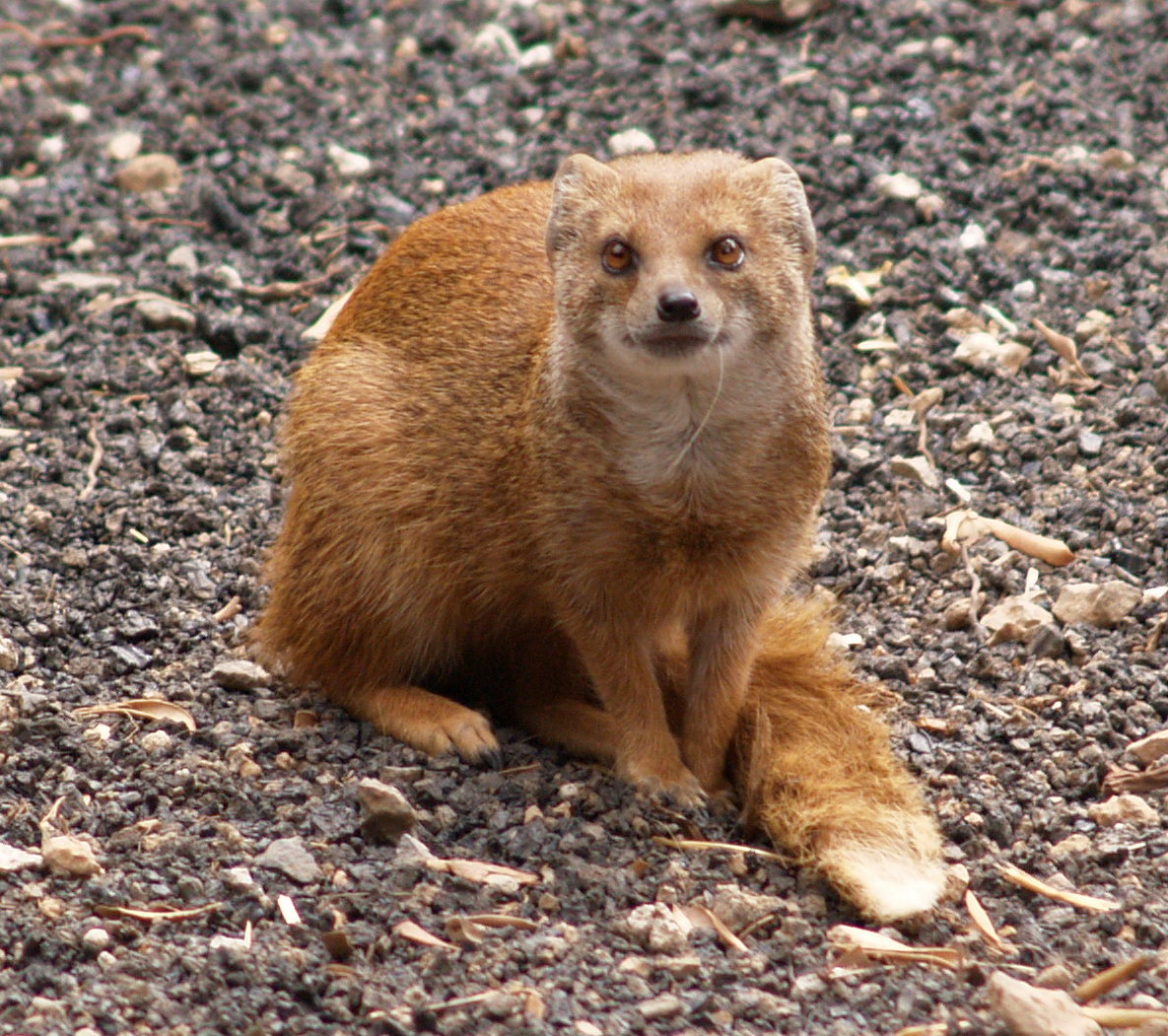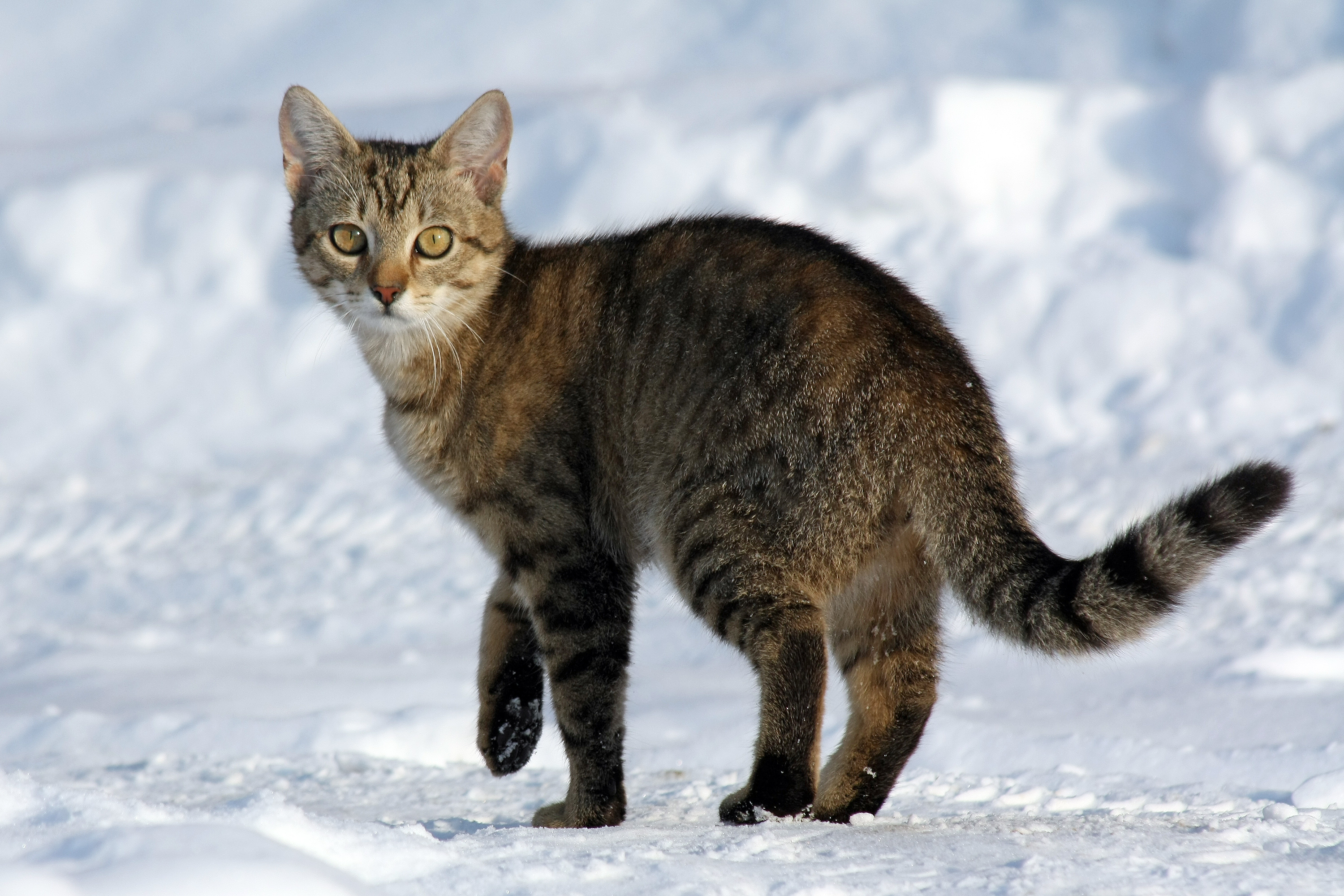|
Feliforms
Feliformia is a suborder within the order Carnivora consisting of "cat-like" carnivorans, including Felidae, cats (large and small), hyenas, mongooses, viverrids, and related taxa. Feliformia stands in contrast to the other suborder of Carnivora, Caniformia consisting of "dog-like" carnivorans (includes Canoidea). The separation of the Carnivora into the broad groups of feliforms and caniforms is widely accepted, as is the definition of Feliformia and Caniformia as suborders (sometimes superfamilies). The classification of feliforms as part of the Feliformia suborder or under separate groupings continues to evolve. Systematic classifications dealing with only extant taxa include all feliforms into the Feliformia suborder, though variations exist in the definition and grouping of families and genera.Taxonomic references - extant species (1): Supporting descriptive information and picturesDiversity Web (online) – Feliformia/ref>Taxonomic references - extant species (2)Integrated ... [...More Info...] [...Related Items...] OR: [Wikipedia] [Google] [Baidu] |
Two-spotted Palm Civet
The African palm civet (''Nandinia binotata''), also known as the two-spotted palm civet, is a small Feliformia, feliform mammal widely distributed in sub-Saharan Africa. It is listed as least concern on the IUCN Red List. Characteristics The African palm civet is grey to dark brown with dark spots on the back. It has short legs, small ears, a lean body, and a long, ringed tail. It has two sets of scent glands on the lower abdomen and between the third and fourth toes on each foot, which secrete a strong-smelling substance used to mark territory and in mating. Adult females reach a body length of with a long tail and weigh . Adult males reach in body length with a long tail and weigh . The African palm civet's ear canal is not divided and cartilaginous at the end. Distribution and habitat The African palm civet ranges throughout much of sub-Saharan Africa from Guinea to South Sudan, south to Angola, and into eastern Zimbabwe. It has been recorded in deciduous forests, lowla ... [...More Info...] [...Related Items...] OR: [Wikipedia] [Google] [Baidu] |
Asiatic Linsang
The Asiatic linsang (''Prionodon'') is a genus comprising two species native to Southeast Asia: the banded linsang (''Prionodon linsang'') and the spotted linsang (''Prionodon pardicolor''). ''Prionodon'' is considered a sister taxon of the Felidae. Characteristics The coat pattern of the Asiatic linsang is distinct, consisting of large spots that sometimes coalesce into broad bands on the sides of the body; the tail is banded transversely. It is small in size with a head and body length ranging from and a long tail. The tail is nearly as long as the head and body, and about five or six times as long as the hind foot. The head is elongated with a narrow muzzle, rhinarium evenly convex above, with wide internarial septum, shallow infranarial portion, and philtrum narrow and grooved, the groove extending only about to the level of the lower edge of the nostrils. The delicate skull is long, low, and narrow with a well defined occipital and a strong crest, but there is no comple ... [...More Info...] [...Related Items...] OR: [Wikipedia] [Google] [Baidu] |
Nandinioidea
The African palm civet (''Nandinia binotata''), also known as the two-spotted palm civet, is a small feliform mammal widely distributed in sub-Saharan Africa. It is listed as least concern on the IUCN Red List. Characteristics The African palm civet is grey to dark brown with dark spots on the back. It has short legs, small ears, a lean body, and a long, ringed tail. It has two sets of scent glands on the lower abdomen and between the third and fourth toes on each foot, which secrete a strong-smelling substance used to mark territory and in mating. Adult females reach a body length of with a long tail and weigh . Adult males reach in body length with a long tail and weigh . The African palm civet's ear canal is not divided and cartilaginous at the end. Distribution and habitat The African palm civet ranges throughout much of sub-Saharan Africa from Guinea to South Sudan, south to Angola, and into eastern Zimbabwe. It has been recorded in deciduous forests, lowland rainfor ... [...More Info...] [...Related Items...] OR: [Wikipedia] [Google] [Baidu] |
Stenoplesictidae
Stenoplesictidae is the name of a polyphyletic family of extinct civet-like feliforms Feliformia is a suborder within the order Carnivora consisting of "cat-like" carnivorans, including Felidae, cats (large and small), hyenas, mongooses, viverrids, and related taxa. Feliformia stands in contrast to the other suborder of Carnivora, .... Taxonomy Classification References * Morlo M. & Nagel D. (2007). "The carnivore guild of the Taatsiin Gol area: Hyaenodontidae (Creodonta), Carnivora, and Didymoconida from the Oligocene of Central Mongolia". ''Annalen des Naturhistorischen Museums Wien'' 108A: 217–231. * Morlo M., Miller E. R. & El-Barkooky A. N. (2007). "Creodonta and Carnivora from Wadi Moghra, Egypt". ''Journal of Vertebrate Paleontology'' 27(1): 145–159. * de Bonis, L., S. Peigne, & M. Hugueney (1999) – "Carnivores feloides de l'Oligocene superieur de Coderet-Bransat (Allier, France)". ''Bulletin de la Société Géologique de France 1999'' 170: 939–949. * Morales, ... [...More Info...] [...Related Items...] OR: [Wikipedia] [Google] [Baidu] |
Middle Eocene
The Eocene ( ) is a geological epoch that lasted from about 56 to 33.9 million years ago (Ma). It is the second epoch of the Paleogene Period in the modern Cenozoic Era. The name ''Eocene'' comes from the Ancient Greek (''Ēṓs'', ' Dawn') and (''kainós'', "new") and refers to the "dawn" of modern ('new') fauna that appeared during the epoch.See: *Letter from William Whewell to Charles Lyell dated 31 January 1831 in: * From p. 55: "The period next antecedent we shall call Eocene, from ήως, aurora, and χαινος, recens, because the extremely small proportion of living species contained in these strata, indicates what may be considered the first commencement, or ''dawn'', of the existing state of the animate creation." The Eocene spans the time from the end of the Paleocene Epoch to the beginning of the Oligocene Epoch. The start of the Eocene is marked by a brief period in which the concentration of the carbon isotope 13C in the atmosphere was exceptionally low in ... [...More Info...] [...Related Items...] OR: [Wikipedia] [Google] [Baidu] |
Aeluroidea
Aeluroidea, Ailuroidea, or Feloidea is the name of a taxon (infraorder or superfamily) comprising cat-like Carnivora. More specifically the taxon comprises:Feliformia, Pan-Feliformia. In: R. L. Carroll. 1988. Vertebrate Paleontology and Evolution. W. H. Freeman and Company, New York 1-698H. N. Bryant. 1991. Phylogenetic relationships and systematics of the Nimravidae (Carnivora). Journal of Mammalogy 72(1):56-78 * either cat-like Carnivora in the broader sense, i.e. it is synonymous with Feliformia (more specifically either Feliformia sensu stricto, i.e. crown Feliformia, or Feliformia sensu lato, i.e. Pan-Feliformia); * or cat-like Carnivora in the narrower sense, i.e. it comprises only the family Felidae (recently also Prionodontidae) and its closest extinct relatives. The Aeluroidea in the first, i.e. broader sense, has been sometimes called infraorder Aeluroida since 1982. The name Feloidea is sometimes used in a third sense—it designates the taxon corresponding to all Fel ... [...More Info...] [...Related Items...] OR: [Wikipedia] [Google] [Baidu] |
Taxa
In biology, a taxon (back-formation from ''taxonomy''; : taxa) is a group of one or more populations of an organism or organisms seen by taxonomists to form a unit. Although neither is required, a taxon is usually known by a particular name and given a particular ranking, especially if and when it is accepted or becomes established. It is very common, however, for taxonomists to remain at odds over what belongs to a taxon and the criteria used for inclusion, especially in the context of rank-based (" Linnaean") nomenclature (much less so under phylogenetic nomenclature). If a taxon is given a formal scientific name, its use is then governed by one of the nomenclature codes specifying which scientific name is correct for a particular grouping. Initial attempts at classifying and ordering organisms (plants and animals) were presumably set forth in prehistoric times by hunter-gatherers, as suggested by the fairly sophisticated folk taxonomies. Much later, Aristotle, and later st ... [...More Info...] [...Related Items...] OR: [Wikipedia] [Google] [Baidu] |
Viverrid
Viverridae is a family (biology), family of small to medium-sized feliform mammals, comprising 14 genera with 33 species. This family was named and first described by John Edward Gray in 1821. Viverrids occur all over Africa, in southern Europe, South Asia, South and Southeast Asia on both sides of the Wallace Line. The word viverridae comes from the Latin word . The species of the subfamily Genettinae are known as Genet (animal), genets and Poiana (genus), oyans. The viverrids of the subfamily Viverrinae are commonly called civets; the Paradoxurinae and most Hemigalinae species are called palm civets. Characteristics Viverrids have four or five toes on each foot and half-retractile claws. They have six incisors in each jaw and Molar (tooth), molars with two tubercular grinders behind in the upper jaw, and one in the lower jaw. The tongue is rough with sharp prickles. A pouch or Anal gland, gland occurs beneath the anus, but there is no cecum. The male's Urinary meatus, urethr ... [...More Info...] [...Related Items...] OR: [Wikipedia] [Google] [Baidu] |
Mongoose
A mongoose is a small terrestrial carnivorous mammal belonging to the family Herpestidae. This family has two subfamilies, the Herpestinae and the Mungotinae. The Herpestinae comprises 23 living species that are native to southern Europe, Africa and Asia, whereas the Mungotinae comprises 11 species native to Africa. The Herpestidae originated about in the Early Miocene and genetically diverged into two main lineages between 19.1 and . There is a large introduced population on the islands of Hawaii. Mongoose diets are varied but consist of mainly insects, hatchlings, reptiles and birds. Etymology The name is derived from names used in India for ''Herpestes'' species: or in classical Hindi; in Marathi; in Telugu; , and in Kannada. The form of the English name (since 1698) was altered to its "- goose" ending by folk etymology. It was spelled "mungoose" in the 18th and 19th centuries. The plural form is "mongooses", although "mongeese" is also used. Characteristics ... [...More Info...] [...Related Items...] OR: [Wikipedia] [Google] [Baidu] |
Hyena
Hyenas or hyaenas ( ; from Ancient Greek , ) are feliform carnivoran mammals belonging to the family Hyaenidae (). With just four extant species (each in its own genus), it is the fifth-smallest family in the order Carnivora and one of the smallest in the class Mammalia. Despite their low diversity, hyenas are unique and vital components of most African ecosystems. Although phylogenetically closer to felines and viverrids, hyenas are behaviourally and morphologically similar to canids in several elements due to convergent evolution: both hyenas and canines are non-arboreal, cursorial hunters that catch prey with their teeth rather than claws. Both eat food quickly and may store it, and their calloused feet with large, blunt, nonretractable claws are adapted for running and making sharp turns. However, hyenas' grooming, scent marking, defecation habits, mating, and parental behavior are consistent with the behavior of other feliforms. Hyenas feature prominently in the fo ... [...More Info...] [...Related Items...] OR: [Wikipedia] [Google] [Baidu] |
Carnivora
Carnivora ( ) is an order of placental mammals specialized primarily in eating flesh, whose members are formally referred to as carnivorans. The order Carnivora is the sixth largest order of mammals, comprising at least 279 species. Carnivorans are found on every major landmass and in a variety of habitats, ranging from the cold polar regions of Earth to the hyper-arid region of the Sahara Desert and the open seas. Carnivorans exhibit a wide array of body plans, varying greatly in size and shape. Carnivora are divided into two suborders, the Feliformia, containing the true felids and several animals; and the Caniformia, containing the true canids and many animals. The feliforms include the Felidae, Viverridae, hyena, and mongoose families, the majority of which live only in the Old World; cats are the only exception, occurring in the Old World and the New World, entering the Americas via the Bering land bridge. The caniforms include the Caninae, Procyonidae, bears, ... [...More Info...] [...Related Items...] OR: [Wikipedia] [Google] [Baidu] |
Percrocutidae
Percrocutidae is an extinct family of hyena-like feliform carnivorans endemic to Asia, Africa, and Southern Europe from the Middle Miocene through the Pliocene, existing for about . The first percrocutids are known from the middle Miocene of Europe and western Asia and belonged to the genus '' Percrocuta''. ''Percrocuta'' already had large premolars, but did not carry such a massive bite as the later form '' Dinocrocuta'', from the later Miocene. Originally, these carnivores were placed with the hyenas in the family Hyaenidae. , most scientists considered the Percrocutidae to be a distinct family that evolved their morphology similar to hyenas due convergent evolution Convergent evolution is the independent evolution of similar features in species of different periods or epochs in time. Convergent evolution creates analogous structures that have similar form or function but were not present in the last comm ..., - although they are usually placed sister-taxa/immediate out ... [...More Info...] [...Related Items...] OR: [Wikipedia] [Google] [Baidu] |






